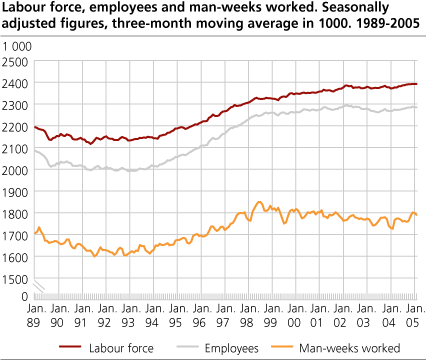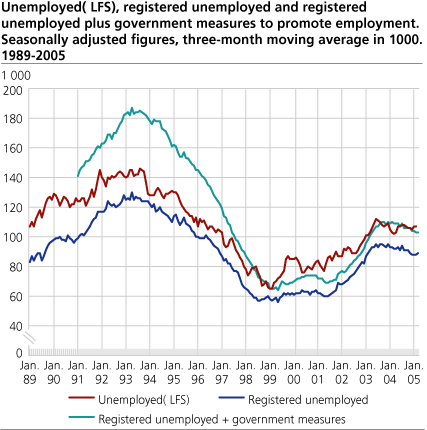Content
Published:
This is an archived release.
More people underemployed
The number of underemployed people increased by 12 000 last year, and women accounted for all of the increase. The figures are taken from the latest Labour Force Survey (LFS) carried out by Statistics Norway.
|
Seasonally adjusted figures: Stable labour market
Unemployment and employment stayed approximately unchanged from the fourth quarter of 2004 to the first quarter of 2005, according to seasonally adjusted figures from the LFS. The changes for both unemployment and employment are inside the LFS error margin. Employment may still follow an upward trend, while unemployment remains on a stable level. The seasonal adjustment method is a favourable method of revealing the current development in the labour market, and serves as an alternative to comparisons with the corresponding quarter in the previous year. Seasonally adjusted figures are presented in a separate article. |
The number of underemployed, i.e. part-time employees who want to work more hours, went up from 97 000 to 109 000 from the first quarter of 2004 to the first quarter of 2005. This represents 17.6 per cent of all part-time employees and compares with 15.6 per cent in the first quarter of 2004. Never before has the number of underemployed been higher since the Norwegian LFS started measuring the under-employment in 1989. Over 60 per cent of the underemployed work in health and social work, and in wholesale, retail trade, hotels and restaurants. In addition, most of the part-time employees are found in the same two industry divisions.
Unchanged labour force participation
Total labour force participation stayed approximately unchanged at 71.8 per cent from the first quarter of 2004 to the first quarter of 2005. Women and men aged 20-24 had a decline, while some increase was found among women aged 30-39.
The total number of employees increased by 13 000 from the first quarter of 2004 to the first quarter of 2005, and the full-time employees accounted for all of the increase. The employment figures by industry reveal a 15 000 increase in wholesale and retail trade employment in the same period. In addition, employment rose by 9 000 in business activities. Agriculture and forestry experienced a fall in employment in this period.
Unchanged temporary employment
The number of temporary employees was 187 000 in the first quarter of 2005, which approximately on level with the first quarter of 2004. Temporary employment was most common in health and social work, education, as well as in hotels and restaurants. At the opposite end of the scale, transport and communication, manufacturing, in addition to construction are characterised by relatively few temporary employees.
Approximately unchanged unemployment
The number of unemployed in the first quarter of 2005 was 110 000, approximately unchanged from the first quarter of 2004. The total unemployment rate was 4.6 per cent, the rate for men 5.0 per cent and the rate for women 4.2 per cent.
The proportion of long-term unemployed increased from 21 to 26 per cent last year. Long-term unemployment is defined as unemployment that has lasted for at least six consecutive months.
Actual hours worked for the unemployed and underemployed amounted to 134 000 man-weeks (full-time work) in the first quarter of 2005, an increase of 10 000 from the corresponding quarter of 2004.
Small changes in international figures
The seasonally adjusted unemployment rate for Norway was 4.5 per cent in February 2005, compared with 4.4 per cent in November 2004. The rate stayed approximately unchanged in the EU and OECD area, at 8.1 and 6.7 per cent respectively. In the same period, the unemployment in the USA stayed unchanged at 5.4 per cent. From November 2004 to February 2005, the unemployment rate increased from 6.4 to 6.5 per cent in Sweden, and in Finland from 8.8 to 9.0 per cent. In the same period, the figures for France and Germany went up 0.2 percentage points, and ended at 9.8 and 9.7 per cent respectively, according to figures from the OECD and Eurostat .
Tables:
- Table 1. Population aged 16-74 in the labour force, man-weeks worked, registered unemployed persons and persons employed by government measures. 1000 and per cent
- Table 2. Population aged 16-74 år in the labour force, employed persons and unemployed persons by sex (LFS). 1000 and per cent
- Table 3. Persons in the labour force and employed persons by age and sex (LFS). 1 000 and per cent
- Table 4. Population aged 16-74, employed persons by settled/usual working hours per week(1) and unemployed persons by age and sex (LFS). 1000
- Table 5. Persons in the labour force by age and sex. 1000 and as per cent of all in each group
- Tabell 6.Employed persons by sex and settled/usual working hours pr week (LFS). 1 000
- Table 7. Population aged 16-74 by main activity, part-time employment1 and age (LFS). 1 000
- Table 8. Employed persons by major industry division. 1000
- Table 9. Number of man-hours worked per week1 by industry division (LFS). 1 000
- Table 10. Employed persons,total, and employed persons at work by status and sex. Number of man-weeks worked1 and actual working hours per week (LFS)
- Table 11. Employed persons and absence from work during the whole survey week by reason for absence and sex(1). 1000 and per cent
- Table 12. Employees with temporary jobs, by major industry division (LFS). 1000 and as per cent of all employees
- Table 13. Unemployed persons by sex and age (LFS). 1000 and per cent
- Table 14. Unemployed persons by duration of job search (LFS). 1000 and per cent
- Table 15. Unemployed persons by main activity (LFS). 1 000
- Table 16. Unemployed and underemployed persons, by sex and desired working hours per week. Number of man-weeks (of 37,5 hours) supplied (LFS). 1000
- Table 17. Employment and unemployment for persons aged 16-74 years, seasonally adjusted, three-months moving average. Absolute figures in 1000 and unemployed persons in per cent of the labour force.
- Table 18. Persons in the labour force by sex and region(LFS). 1 000 and in per cent of total
- Table 19. Employed persons by sex and region (LFS). 1 000
- Table 20. Employed persons by sex and regions (LFS) as per cent of all inn each group
- Table 21 Employed persons, by some major industry division and region (LFS). 1997-2004. 1 000
Contact
-
Arbeidsmarked og lønn
E-mail: arbeidsmarked@ssb.no
-
Erik Herstad Horgen
E-mail: erik.horgen@ssb.no
tel.: (+47) 93 08 68 62
-
Håvard Hungnes Lien
E-mail: havard.lien@ssb.no
tel.: (+47) 40 90 26 06


